VLA Data Combination-CASA4.6.0
This tutorial was created and tested using CASA 4.6.0
Introduction
The VLA can be configured into four principal array configurations, A, B, C, and D. A is the most extended and D the most compact configuration. Consequently, A configuration data has the highest spatial resolution whereas D delivers the best surface brightness sensitivity and also images the largest scales on the sky distribution. The best possible picture of an object is to combine different array combinations.
In this tutorial, we will combine data from the surroundings of Sgr A*, the central, supermassive black hole of our Milky Way.
Typical Observation times
When an object is being observed by the VLA in different configurations, ideally integration times are matched by their surface brightness sensitivity. Adjacent VLA configurations result in synthesized beams that differ in linear size by are approximately a factor of 3. The beam area is thus about 10 times different and the more extended configuration would ideally need to be 10 times longer than the most compact one. This, however, is frequently not very practical and it turns out that integration times that differ by factors of 3 are delivering data that can be combined quite well as it matches the sensitivity of overlapping VLA visibilities when data are convcolved to the same scales.
This rule, however, is only a guidance and any data that is being obtained can be combined. Weighting will then be primarily achieved by the image "Briggs" scheme that produces weights between the "natural" and "uniform" extremes, i.e. between weighting by the number of visibilities that are gridded in each cell and weighting by the cells themselves.
In addition, each visibility exhibits weights that should only depend on integration time, bandwidth, and system temperature. The VLA, however, currently does not measure Tsys and weights between different observations will need to be adjusted as described below.
The data
In the following we will combine three different datasets from the [NRAO Monitoring of the Galactic Center/G2 Cloud Encounter]. We will combine S-band A, B, and C configuration data. At this stage, the data were all calibrated and the science target split out.
The measurement sets can be downloaded here:
https://casa.nrao.edu/Data/EVLA/SgrA/VLA-combination-SgrA-files.tar.gz (1.4GB)
As a first step, let's download the files, then untar:
# In Terminal
tar -xzvf VLA-combination-SgrA-files.tar.gz
There will now be three unpacked MeasurementSets, one for each configuration:
VLA-SgrA-Sband-Aconfig.ms VLA-SgrA-Sband-Bconfig.ms VLA-SgrA-Sband-Cconfig.ms
Initial Imaging
To start with, we will make first, quick images to check the integrity of the data.
Start CASA as usual via
# In Terminal
casa
To start with, let's have a look at the listobs output for the different files. For example, the A-configuration data had the following structure:
# In CASA
listobs(vis='VLA-SgrA-Sband-Aconfig.ms')
##########################################
##### Begin Task: listobs #####
listobs(vis="VLA-SgrA-Sband-Aconfig.ms",selectdata=True,spw="",field="",antenna="",
uvrange="",timerange="",correlation="",scan="",intent="",
feed="",array="",observation="",verbose=True,listfile="",
listunfl=False,cachesize=50,overwrite=False)
================================================================================
MeasurementSet Name: /lustre/aoc/sciops/jott/casa/topicalguide/combination/test/VLA-SgrA-Sband-Aconfig.ms MS Version 2
================================================================================
Observer: lorant sjouwerman Project: uid://evla/pdb/11434214
Observation: EVLA
Data records: 528000 Total elapsed time = 360 seconds
Observed from 31-May-2014/09:07:57.0 to 31-May-2014/09:13:57.0 (UTC)
Compute subscan properties
ObservationID = 0 ArrayID = 0
Date Timerange (UTC) Scan FldId FieldName nRows SpwIds Average Interval(s) ScanIntent
31-May-2014/09:07:57.0 - 09:13:57.0 63 0 J1745-2900 528000 [0,3,4,5,6,7,8,9,10,11,12,13,14,15] [3, 3, 3, 3, 3, 3, 3, 3, 3, 3, 3, 3, 3, 3] [OBSERVE_TARGET#UNSPECIFIED]
(nRows = Total number of rows per scan)
Fields: 1
ID Code Name RA Decl Epoch SrcId nRows
0 NONE J1745-2900 17:45:40.038300 -29.00.28.06899 J2000 0 528000
Spectral Windows: (14 unique spectral windows and 1 unique polarization setups)
SpwID Name #Chans Frame Ch0(MHz) ChanWid(kHz) TotBW(kHz) CtrFreq(MHz) BBC Num Corrs
0 EVLA_S#A0C0#80 64 TOPO 1988.000 2000.000 128000.0 2051.0000 12 RR LL
3 EVLA_S#A0C0#83 64 TOPO 2372.000 2000.000 128000.0 2435.0000 12 RR LL
4 EVLA_S#A0C0#84 64 TOPO 2500.000 2000.000 128000.0 2563.0000 12 RR LL
5 EVLA_S#A0C0#85 64 TOPO 2628.000 2000.000 128000.0 2691.0000 12 RR LL
6 EVLA_S#A0C0#86 64 TOPO 2756.000 2000.000 128000.0 2819.0000 12 RR LL
7 EVLA_S#A0C0#87 64 TOPO 2884.000 2000.000 128000.0 2947.0000 12 RR LL
8 EVLA_S#B0D0#88 64 TOPO 2988.000 2000.000 128000.0 3051.0000 15 RR LL
9 EVLA_S#B0D0#89 64 TOPO 3116.000 2000.000 128000.0 3179.0000 15 RR LL
10 EVLA_S#B0D0#90 64 TOPO 3244.000 2000.000 128000.0 3307.0000 15 RR LL
11 EVLA_S#B0D0#91 64 TOPO 3372.000 2000.000 128000.0 3435.0000 15 RR LL
12 EVLA_S#B0D0#92 64 TOPO 3500.000 2000.000 128000.0 3563.0000 15 RR LL
13 EVLA_S#B0D0#93 64 TOPO 3628.000 2000.000 128000.0 3691.0000 15 RR LL
14 EVLA_S#B0D0#94 64 TOPO 3756.000 2000.000 128000.0 3819.0000 15 RR LL
15 EVLA_S#B0D0#95 64 TOPO 3884.000 2000.000 128000.0 3947.0000 15 RR LL
Sources: 16
ID Name SpwId RestFreq(MHz) SysVel(km/s)
0 J1745-2900 0 - -
0 J1745-2900 1 - -
0 J1745-2900 2 - -
0 J1745-2900 3 - -
0 J1745-2900 4 - -
0 J1745-2900 5 - -
0 J1745-2900 6 - -
0 J1745-2900 7 - -
0 J1745-2900 8 - -
0 J1745-2900 9 - -
0 J1745-2900 10 - -
0 J1745-2900 11 - -
0 J1745-2900 12 - -
0 J1745-2900 13 - -
0 J1745-2900 14 - -
0 J1745-2900 15 - -
Antennas: 26:
ID Name Station Diam. Long. Lat. Offset from array center (m) ITRF Geocentric coordinates (m)
East North Elevation x y z
0 ea01 N32 25.0 m -107.37.22.0 +33.56.33.6 -441.7442 4689.9683 -16.9356 -1600781.062100 -5039347.430600 3558761.526300
1 ea02 N64 25.0 m -107.37.58.7 +34.02.20.5 -1382.3632 15410.1417 -40.6233 -1599855.668100 -5033332.388100 3567636.626500
2 ea03 E64 25.0 m -107.27.00.1 +33.50.06.7 15507.5911 -7263.7210 67.2006 -1587600.203200 -5050575.869700 3548885.404900
3 ea04 E24 25.0 m -107.35.13.4 +33.53.18.1 2858.1804 -1349.1324 13.7306 -1598663.094300 -5043581.396100 3553767.023200
4 ea05 W08 25.0 m -107.37.21.6 +33.53.53.0 -432.1181 -272.1470 -1.5057 -1601614.092200 -5042001.651900 3554652.509800
5 ea06 N56 25.0 m -107.37.47.9 +34.00.38.4 -1105.2076 12254.3155 -34.2423 -1600128.382500 -5035104.142000 3565024.679400
6 ea07 N48 25.0 m -107.37.38.1 +33.59.06.2 -855.2644 9405.9610 -25.9303 -1600374.875000 -5036704.207500 3562667.885900
7 ea08 N16 25.0 m -107.37.10.9 +33.54.48.0 -155.8517 1426.6442 -9.3792 -1601061.957400 -5041175.883000 3556058.040000
8 ea09 W64 25.0 m -107.46.20.1 +33.48.50.9 -14240.7638 -9606.2696 17.1066 -1616361.587500 -5042770.516600 3546911.446900
9 ea10 E40 25.0 m -107.32.35.4 +33.52.16.9 6908.8305 -3240.7192 39.0202 -1595124.923100 -5045829.467200 3552210.703600
10 ea11 W24 25.0 m -107.38.49.0 +33.53.04.0 -2673.3552 -1784.5888 10.4757 -1604008.749300 -5042135.808900 3553403.716000
11 ea12 N09 25.0 m -107.37.07.8 +33.54.19.0 -77.4204 530.6453 -5.5755 -1601139.471200 -5041679.039700 3555316.553900
12 ea13 W56 25.0 m -107.44.26.7 +33.49.54.6 -11333.2004 -7637.6771 15.3707 -1613255.393400 -5042613.099800 3548545.915000
13 ea14 E08 25.0 m -107.36.48.9 +33.53.55.1 407.8298 -206.0320 -3.2196 -1600801.931000 -5042219.386500 3554706.431200
14 ea15 E56 25.0 m -107.29.04.1 +33.50.54.9 12327.6313 -5774.7469 42.6153 -1590380.611000 -5048810.243300 3550108.432300
15 ea17 E32 25.0 m -107.34.01.5 +33.52.50.3 4701.6413 -2209.7152 25.2066 -1597053.135800 -5044604.681200 3553058.995000
16 ea18 E72 25.0 m -107.24.42.3 +33.49.18.0 19041.8717 -8769.2047 4.7262 -1584460.871200 -5052385.599800 3547600.000100
17 ea19 W16 25.0 m -107.37.57.4 +33.53.33.0 -1348.7109 -890.6216 1.3005 -1602592.853600 -5042054.996800 3554140.704800
18 ea20 N40 25.0 m -107.37.29.5 +33.57.44.4 -633.6074 6878.6018 -20.7693 -1600592.756000 -5038121.357300 3560574.853200
19 ea21 E48 25.0 m -107.30.56.1 +33.51.38.4 9456.6097 -4431.6564 37.9341 -1592894.077600 -5047229.138200 3551221.206000
20 ea22 N24 25.0 m -107.37.16.1 +33.55.37.7 -290.3752 2961.8594 -12.2389 -1600930.087800 -5040316.396400 3557330.387200
21 ea23 W72 25.0 m -107.48.24.0 +33.47.41.2 -17419.4740 -11760.2758 14.9538 -1619757.312900 -5042937.664400 3545120.392300
22 ea24 W48 25.0 m -107.42.44.3 +33.50.52.1 -8707.9403 -5861.7877 15.5282 -1610451.925800 -5042471.125800 3550021.055800
23 ea25 W32 25.0 m -107.39.54.8 +33.52.27.2 -4359.4392 -2923.1244 11.7721 -1605808.634900 -5042230.089000 3552459.209500
24 ea26 W40 25.0 m -107.41.13.5 +33.51.43.1 -6377.9880 -4286.7769 8.2038 -1607962.463800 -5042338.190100 3551324.947500
25 ea28 E16 25.0 m -107.36.09.8 +33.53.40.0 1410.0378 -673.4764 -0.7821 -1599926.107500 -5042772.979700 3554319.790400
##### End Task: listobs #####
##########################################
We see that A-configuration contains only the central source, "J1745-2900" which is a different name for Sgr A*. The integration time spans only a five minutes and the 15 spectral windows span a frequency range from 1.988 to 4.012GHz (when adding the bandwidth to the first channel of the last subband). Inspection of the other configuration files show almost identical setups. Although the integration times to not conform to what we discussed earlier, the data can still be combined.
Let's check the uv-coverages of the three datasets.
# In CASA
# A-config:
plotuv(vis='VLA-SgrA-Sband-Aconfig.ms')
#
# B-config
plotuv(vis='VLA-SgrA-Sband-Bconfig.ms')
#
# C-config:
plotuv(vis='VLA-SgrA-Sband-Cconfig.ms')
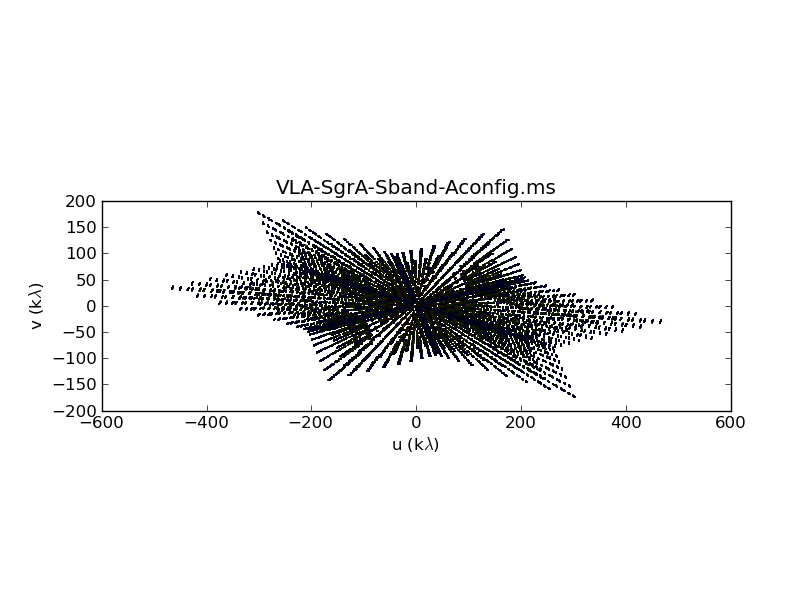 UV-coverage of A-configuration data. |
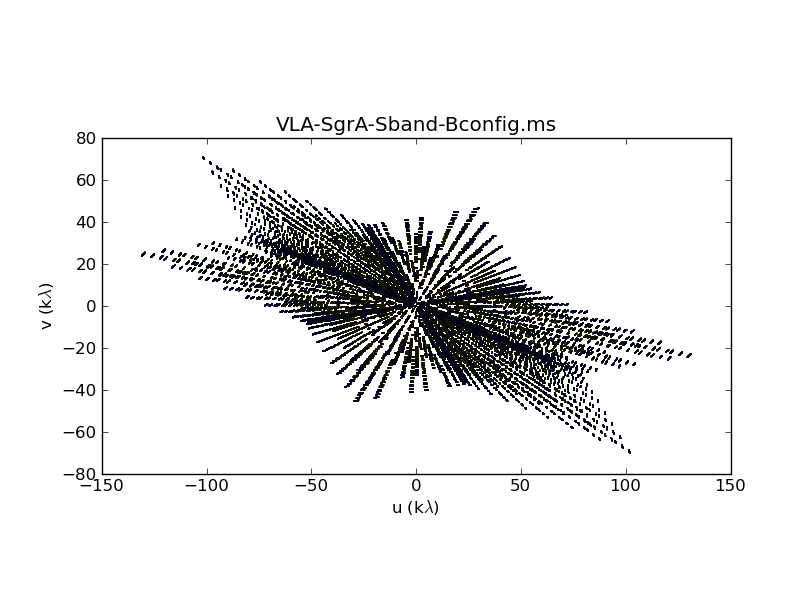 UV-coverage of B-configuration data. |
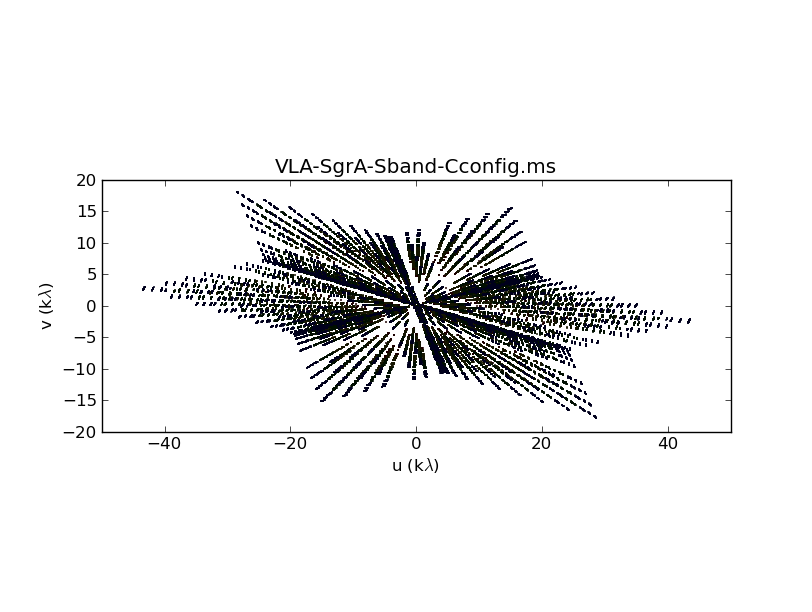 UV-coverage of C-configuration data. |
The next step is to determine the image quality, the synthesized beam, and the rms of each image. So we will performs simple imaging with 1000 iterations on each MS.
To make things easy, we will use the same, common cell size of 0.1 arcsec and the same image size for each configuration.
# In CASA
# A-config:
clean(vis='VLA-SgrA-Sband-Aconfig.ms', imagename='SgrA-Aonly',field='J1745-2900',
mode='mfs',cell='0.1arcsec',imsize=[1280,1280],niter=1000,weighting='briggs',robust=0)
#
# B-config
clean(vis='VLA-SgrA-Sband-Bconfig.ms', imagename='SgrA-Bonly',field='J1745-2900',
mode='mfs',cell='0.1arcsec',imsize=[1280,1280],niter=1000,weighting='briggs',robust=0)
#
# C-config:
clean(vis='VLA-SgrA-Sband-Cconfig.ms', imagename='SgrA-Conly',field='J1745-2900',
mode='mfs',cell='0.1arcsec',imsize=[1280,1280],niter=1000,weighting='briggs',robust=0)
The clean images are not yet ideal. In particular, there are streaks across the entire image. After comparing their orientation with the psf, it is clear that they result from imperfect uv-coverage due to the short integration times of the observations. To get better images, we recommend the setting of clean boxes in the interactive=True interactive mode.
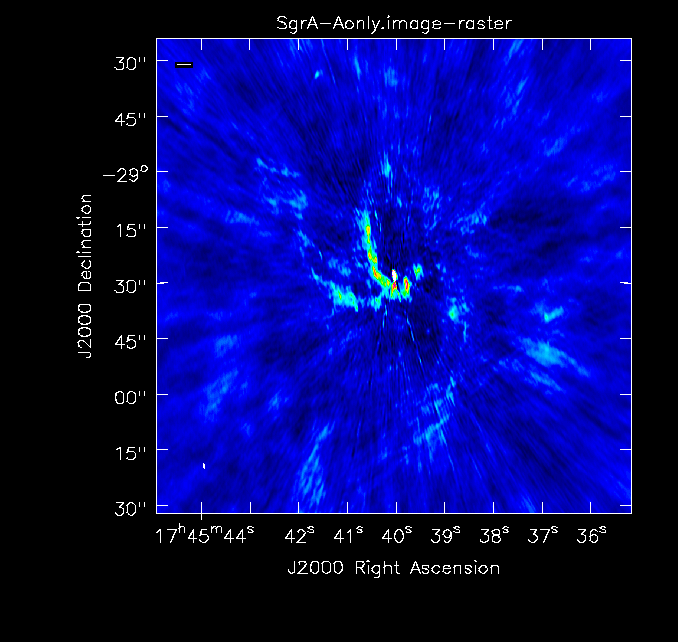 Simple image of A-configuration data. |
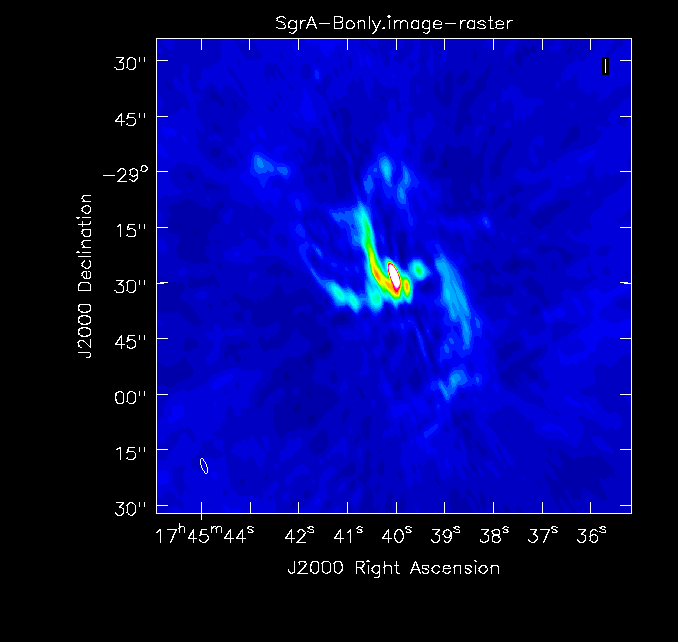 Simple image of B-configuration data. |
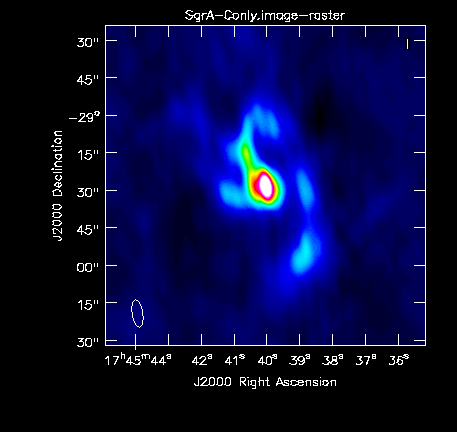 Simple image of C-configuration data. |
For the basic parameters, we find the following:
For A-configuration the synthesized beam is: 1.44" x 0.40" , the rms: ~0.8mJy, and the peak flux of Sgr A* is: 0.712 Jy
For B-configuration the synthesized beam is: 4.33" x 1.34" , the rms: ~0.7mJy, and the peak flux of Sgr A* is: 0.691 Jy
For C-configuration the synthesized beam is: 11.02" x 4.20" , the rms: ~0.6mJy, and the peak flux of Sgr A* is: 1.35 Jy
Although the cleaning could have been better, the image quality of all three datasets is good enough for combination. In fact, adding all uv-coverages together will increase the image quality substantially.
Check and Adjust the Visibility Weights
The VLA does not measure system temperatures and does not have calibrated weights. However, the relative sensitivity within an observation is measured by the gain, so weights of a continuous observation are consistent. It is important though to adjust the weights between different observations. The task statwt in CASA will recalculate the visibility weights based on their rms. This task needs to be executed on each visibility dataset. Typically the default setting works quite well for continuum observations. Note that for spectral line data one should specify the fitspw parameter to exclude the line from the calculations as it will be down-weighes otherwise.
Let's have a look at the weights before running statwt:
# In CASA
# A-config:
plotms(vis='VLA-SgrA-Sband-Aconfig.ms',spw='3',averagedata=T,
avgchannel='128',xaxis='uvwave',yaxis='wt',coloraxis='antenna1')
#
# B-config
plotms(vis='VLA-SgrA-Sband-Bconfig.ms',spw='3',averagedata=T,
avgchannel='128',xaxis='uvwave',yaxis='wt',coloraxis='antenna1')
#
# C-config:
plotms(vis='VLA-SgrA-Sband-Cconfig.ms',spw='3',averagedata=T,
avgchannel='128',xaxis='uvwave',yaxis='wt',coloraxis='antenna1')
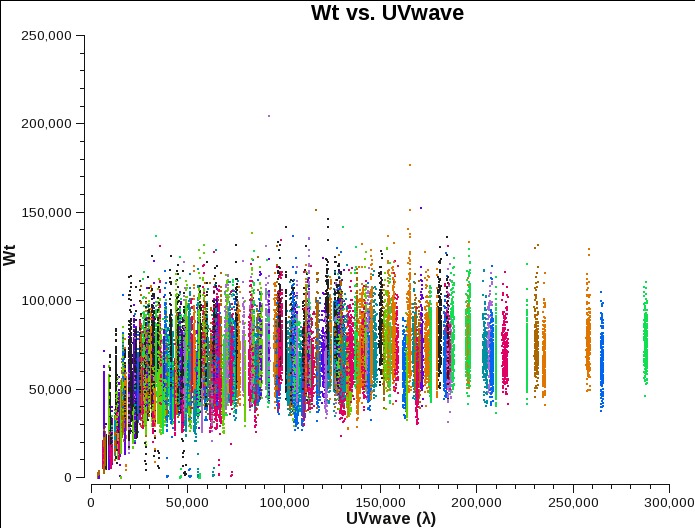 A-config Original Weights. |
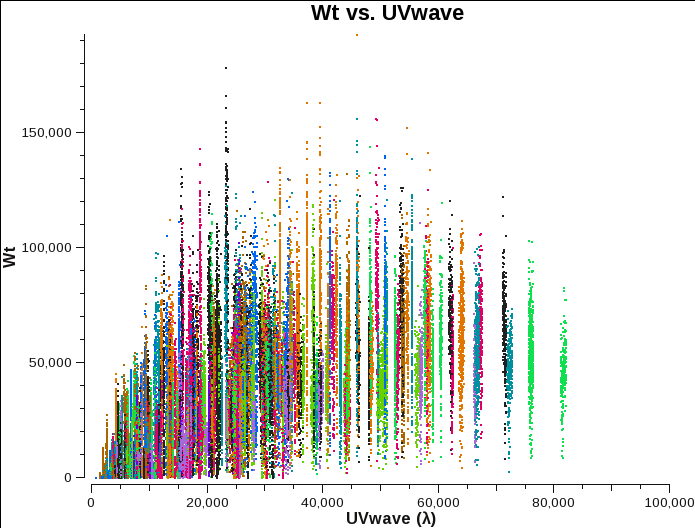 B-config Original Weights. |
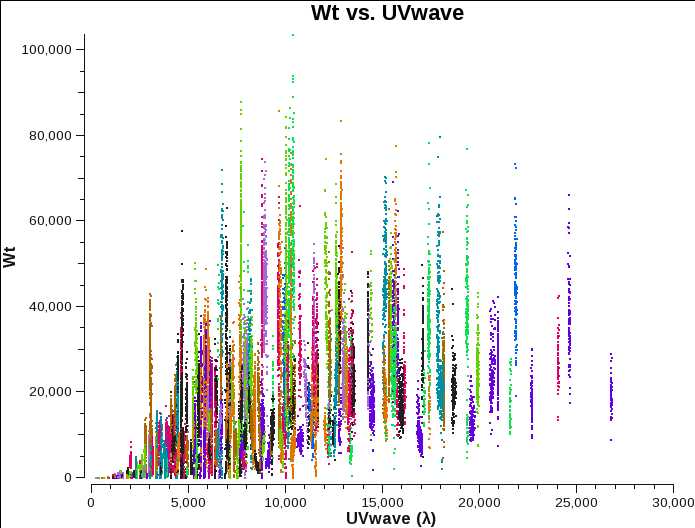 C-config Original Weights. |
We will use the default setting of statwt (calculation for each spw and scan per baseline). As statwt will overwrite the WEIGHT column, we first will create copies of our data:
# In Linux
cp -r VLA-SgrA-Sband-Aconfig.ms VLA-SgrA-Sband-Aconfig-statwt.ms
cp -r VLA-SgrA-Sband-Bconfig.ms VLA-SgrA-Sband-Bconfig-statwt.ms
cp -r VLA-SgrA-Sband-Cconfig.ms VLA-SgrA-Sband-Cconfig-statwt.ms
# In CASA
# A-config:
statwt(vis='VLA-SgrA-Sband-Aconfig-statwt.ms')
#
# B-config
statwt(vis='VLA-SgrA-Sband-Bconfig-statwt.ms')
#
# C-config:
statwt(vis='VLA-SgrA-Sband-Cconfig-statwt.ms')
# In CASA
# A-config:
plotms(vis='VLA-SgrA-Sband-Aconfig-statwt.ms',spw='3',averagedata=T,
avgchannel='128',xaxis='uvwave',yaxis='wt',coloraxis='antenna1')
#
# B-config
plotms(vis='VLA-SgrA-Sband-Bconfig-statwt.ms',spw='3',averagedata=T,
avgchannel='128',xaxis='uvwave',yaxis='wt',coloraxis='antenna1')
#
# C-config:
plotms(vis='VLA-SgrA-Sband-Cconfig-statwt.ms',spw='3',averagedata=T,
avgchannel='128',xaxis='uvwave',yaxis='wt',coloraxis='antenna1')
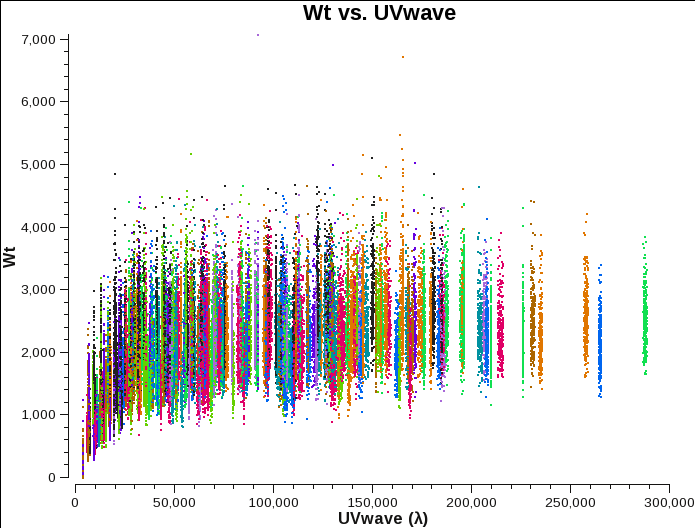 A-config Original Weights. |
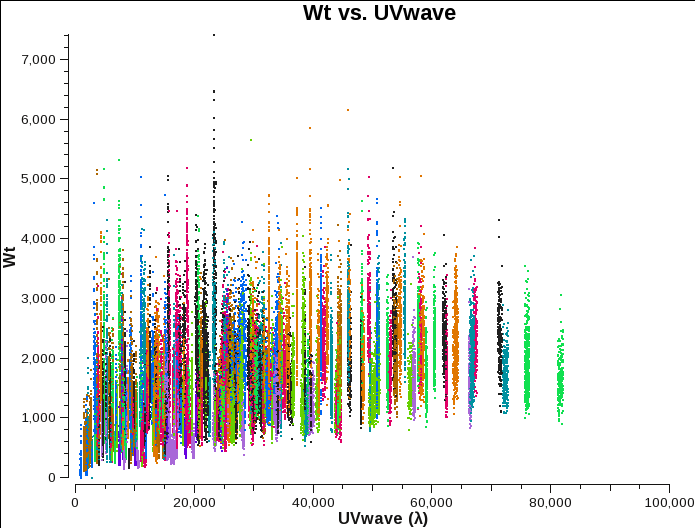 B-config Original Weights. |
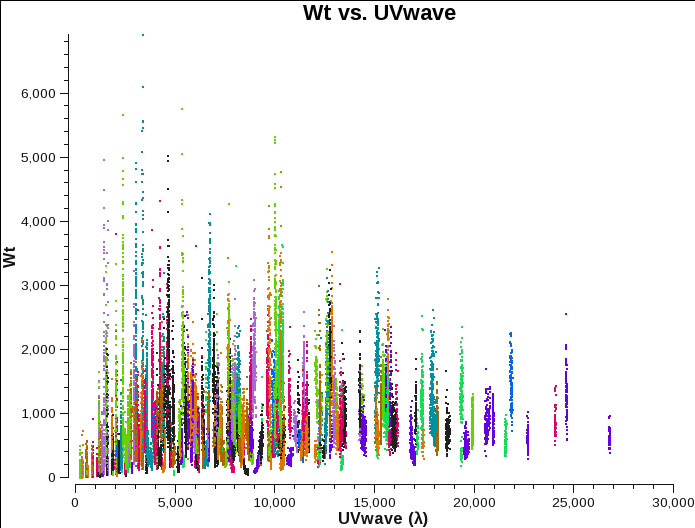 C-config Original Weights. |
Removal of the variable Sgr A* point source
This step is only necessary for our case which includes a variable source. In most cases, one can skip this step.
As we have seen in the initial imaging step, Sgr A* is a variable sourcce. Unfortunately, this also introduces some problems with the visibilities as the different uv points will then also show different values. Cleaning will be difficult in such a situation. We therefore will remove Sgr A* in each dataset and intrduce an averaged value later.
This will be done by creating a component list, that includes only a point source at the position of Sgr A*. The component list will then be inserted into the respective MS into the model column via ft, and uvsub will subtract the point source model from the CORRECTED data column. Since there's no CORRECTED column to start with, uvsub will create it. Note that that imples that running uvsub twice will oversubtract. So we recommend to again, make copies of the previous datasets.
# In Linux
cp -r VLA-SgrA-Sband-Aconfig-statwt.ms VLA-SgrA-Sband-Aconfig-statwt-sub.ms
cp -r VLA-SgrA-Sband-Bconfig-statwt.ms VLA-SgrA-Sband-Bconfig-statwt-sub.ms
cp -r VLA-SgrA-Sband-Cconfig-statwt.ms VLA-SgrA-Sband-Cconfig-statwt-sub.ms
Let's start with the A-configuration data and create a component list:
# In CASA
cl.addcomponent(flux=0.712, fluxunit='Jy',shape='point', dir='J2000 17:45:40.03599 -29.00.28.1699')
cl.rename('component-SgrA-A.cl')
cl.close()
Now we have a file 'component-SgrA-A.cl' that we attach to the model column of the file:
# In CASA
ft(vis='VLA-SgrA-Sband-Aconfig-statwt-sub.ms', complist='component-SgrA-A.cl')
And finally we will subtract the model from the data:
# In CASA
uvsub(vis='VLA-SgrA-Sband-Aconfig-statwt-sub.ms')
Note that to revert back to the original state, one could split out the DATA column and strip the MODEL and the point source subtracted CORRECTED column.
Let's repeat the steps for B-configuration:
# In CASA
cl.addcomponent(flux=0.691, fluxunit='Jy',shape='point', dir='J2000 17:45:40.03599 -29.00.28.1699')
cl.rename('component-SgrA-B.cl')
cl.close()
#
ft(vis='VLA-SgrA-Sband-Bconfig-statwt-sub.ms', complist='component-SgrA-B.cl')
#
uvsub(vis='VLA-SgrA-Sband-Bconfig-statwt-sub.ms')
And for C-configuration:
# In CASA
cl.addcomponent(flux=1.35, fluxunit='Jy',shape='point', dir='J2000 17:45:40.03599 -29.00.28.1699')
cl.rename('component-SgrA-C.cl')
cl.close()
#
ft(vis='VLA-SgrA-Sband-Cconfig-statwt-sub.ms', complist='component-SgrA-C.cl')
#
uvsub(vis='VLA-SgrA-Sband-Cconfig-statwt-sub.ms')
Finally, we will add back in a point source with a canonical 1Jy to bring back Sgr A*. reverse=T will add instead of subtract the model in uvsub.
# In CASA
cl.addcomponent(flux=1, fluxunit='Jy',shape='point', dir='J2000 17:45:40.03599 -29.00.28.1699')
cl.rename('component-SgrA.cl')
cl.close()
#
# A-config
#
ft(vis='VLA-SgrA-Sband-Aconfig-statwt-sub.ms', complist='component-SgrA.cl')
#
uvsub(vis='VLA-SgrA-Sband-Bconfig-statwt-sub.ms',reverse=T)
#
# B-config
#
ft(vis='VLA-SgrA-Sband-Bconfig-statwt-sub.ms', complist='component-SgrA.cl')
#
uvsub(vis='VLA-SgrA-Sband-Bconfig-statwt-sub.ms',reverse=T)
#
# C-config
#
ft(vis='VLA-SgrA-Sband-Cconfig-statwt-sub.ms', complist='component-SgrA.cl')
#
uvsub(vis='VLA-SgrA-Sband-Bconfig-statwt-sub.ms',reverse=T)
Image Combined Data
We can now make a combined image of all thre re-weighted datasets. The data could be combined with concat, but this is in fact not needed. clean will take care of the combination. By default, clean will image the data in the CORRECTED column, i.e. it will use the data where we subtracted the point source earlier.
To start with, we will just fill in the uv-plane, all relative weighting between the different array configurations will be performed with the robust weights. Note that the flux value for Sgr A* will also be a weighted mean of the three different datasets.
First, let's check the new uv-coverage. TO do so, we need to concatenate the data:
# In CASA
concat(vis=['VLA-SgrA-Sband-Aconfig-statwt-sub.ms','VLA-SgrA-Sband-Bconfig-statwt-sub.ms','VLA-SgrA-Sband-Cconfig-statwt-sub.ms'],concatvis='VLA-SgrA-Sband-combined.ms')
# In CASA
plotuv(vis='VLA-SgrA-Sband-combined.ms')
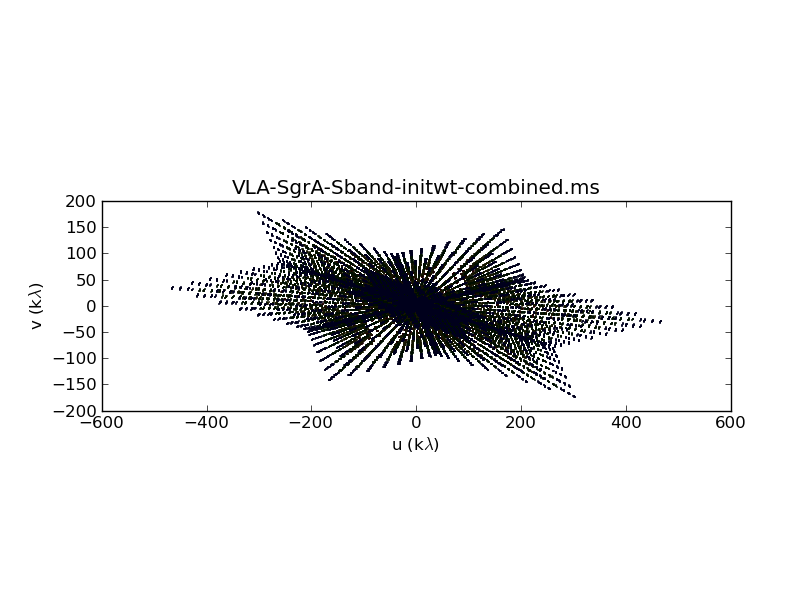 Combined uv-coverage. |
clean also accepts multiple files. We could use the concatenated visibilities that we just created, but let's simply use all three measurement sets for input.
# In CASA
clean(vis=['VLA-SgrA-Sband-Aconfig-statwt-sub.ms','VLA-SgrA-Sband-Bconfig-statwt-sub.ms','VLA-SgrA-Sband-Cconfig-statwt-sub.ms'],
imagename='SgrA-all',field='J1745-2900',mode='mfs',cell='0.1arcsec',imsize=[1280,1280],niter=5000,
threshold='5mJy',weighting='briggs',robust=0)
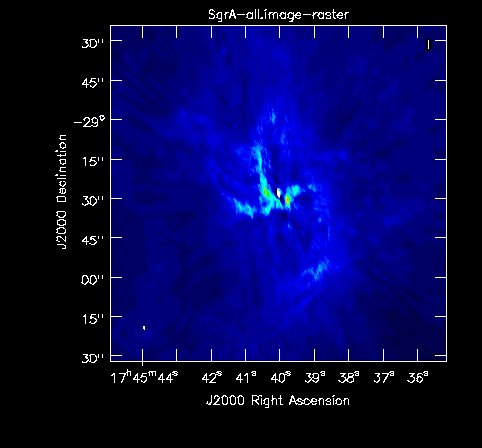 Combined image. |
The resulting image has a beam size of 1.58" x 0.50", very similar to the resolution of A-confguration only. This is what we want to achieve. The rms is better than A-only and there are clearly many more scales in the image. This is pretty good combination product.
The image can still be improved. For simplicity, we did not use any interactive cleaning above, but we highly recommend it for the final images. Improvements can also be obtained, e.g. by adjusting the image weights (robust parameter), adding a taper, or weighting the different datasets against each other (using concat). Wide-band imaging and multi-scale imaging will also improve the results. We refer to the VLA CASA Imaging Guide for more details.
Last checked on CASA Version 4.6.0